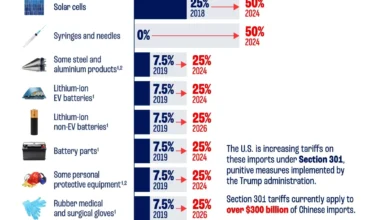New York Bottle Deposit Increase to Help Recycling Efforts

The New York bottle deposit increase is garnering significant attention as lawmakers propose to raise the deposit from 5 to 10 cents and expand the range of beverages included. This move aims to bolster recycling efforts and tackle litter effectively by adding commonly consumed drinks like iced tea and sports drinks to the deposit law in New York. With proven success seen in other states, where redemption rates soar above 90%, advocates assert that this updated initiative could lead to greater environmental benefits. Furthermore, the proposed changes could generate an estimated $100 million annually in state revenue from unreturned beverage containers, a critical addition to New York’s fiscal health. The original bottle deposit law, enacted in 1982, had already made significant strides in reducing litter by 70%, and many believe that modernizing this policy is crucial for today’s environmental landscape.
In light of recent discussions, New York’s proposed increase in beverage container deposits seeks to modernize recycling laws and enhance litter reduction initiatives across the state. By doubling the bottle deposit and encompassing a wider range of drink options, this initiative promises to improve waste management while benefiting the environment. Advocates highlight the importance of adapting existing environmental policy in New York to address current challenges, making it clear that supporting such legislation is vital for sustainable development. As lawmakers explore these expanded regulations, the focus remains on increasing public participation in recycling programs and improving overall redemption rates. This evolution in beverage container deposits may very well redefine New York’s approach to environmental stewardship.
Overview of the Proposed Increase in Bottle Deposit
The New York bottle deposit increase is a significant legislative proposal currently under consideration by lawmakers. This increase would see the bottle deposit raised from 5 to 10 cents, which has sparked a robust discussion surrounding beverage container deposits in New York. Notably, the initiative not only targets traditional soda bottles but aims to expand the deposit law to include a wider variety of beverages such as iced tea, sports drinks, wine, and liquor. Proponents of the bill argue that expanding the deposit system can lead to greater recycling opportunities and a noticeable decrease in litter.
Implementing a deposit increase has been shown to drive better recycling practices in other states, with reported redemption rates as high as 90%. This elevated redemption could transform New York’s approach to waste management and recycling. As residents become more incentivized to return their bottles for a higher refund, it is anticipated that this change could contribute to a cleaner environment. The proposal reflects a more comprehensive environmental policy New York, focusing on contemporary issues surrounding waste and litter reduction initiatives.
Impact on Recycling and Litter Reduction
The impact of the proposed New York bottle deposit increase could be transformative for local ecosystems and communities by significantly enhancing recycling efforts. By making it financially beneficial for individuals to return every beverage container, not only would litter be reduced, but also more materials would be diverted from landfills. The addition of various drinks under the deposit law aligns with a broader goal of modernizing recycling laws in New York to ensure they meet the needs of today’s consumers and environmental challenges.
Moreover, the previously enacted deposit law in 1982 successfully reduced litter by 70%, which demonstrates the effectiveness of such initiatives. Modernizing this law to accommodate the changing beverage landscape is viewed as a necessary step to address current litter challenges. Advocates contend that with the revenue generated from unreturned deposits—the proposal estimates up to $100 million annually—the state could enhance its recycling programs significantly, thereby further amplifying the positive environmental impact.
Economic Benefits of Expanded Bottle Deposits
Beyond environmental implications, the economic benefits of increasing bottle deposits in New York are noteworthy. With the potential to generate upwards of $100 million from unreturned containers, these funds could be allocated to furthering recycling efforts and funding litter reduction initiatives across the state. The beverage industry, too, may adapt positively to the change, supporting the expanded laws as a means to boost their sustainability efforts and appeal to environmentally-conscious consumers.
In addition, the increased bottle deposit could create jobs within the recycling sector as redemption centers may see a rise in traffic and necessitate more workforce to handle the influx of containers. This not only bolsters the state’s economy but fosters a culture of sustainability and responsibility among its residents. Overall, the proposed change stands to benefit both the environment and the economy, embodying the goal of an ethical and pragmatic environmental policy in New York.
Challenges and Criticisms of the Proposed Legislation
While the proposal for a New York bottle deposit increase garners a lot of support, it is not without its challenges and criticisms. Opponents question the financial impact on beverage companies, arguing that the increased cost of deposits could be passed on to consumers, leading to higher prices for drinks. This concern raises questions about the potential burden on families who may already be facing increased costs of living.
Additionally, critics highlight logistical challenges in implementing the expanded beverage types. Ensuring that retailers are equipped and ready for the new deposit system could prove to be a considerable hurdle. As lawmakers consider these criticisms, it is essential to find a balance that does not hinder consumer access while enhancing recycling efforts, ultimately serving the community’s environmental and economic interests.
Comparative Analysis with Other States’ Deposit Laws
When comparing New York’s current deposit system with those in other states, it is clear that the proposed increase stands to align New York more closely with successful models. States such as Michigan, which features a 10-cent deposit, boast some of the highest redemption rates in the country, proving the effectiveness of higher deposits. These examples serve not just as inspiration but as evidence that an increase could lead to greater recycling success and effective litter reduction.
Moreover, the inclusion of a wider array of beverage containers—as seen in states like California—demonstrates how comprehensive bottle deposit legislation can play a vital role in achieving substantial environmental benefits. New York’s addition of iced tea, liquor, and other beverages reinforces the need to modernize its recycling laws. By evaluating how these approaches have succeeded elsewhere, New York can refine its proposed policies to maximize their effectiveness and ensure a well-rounded environmental strategy.
Public Opinion and Stakeholder Engagement
Public opinion plays a crucial role in advancing the proposed New York bottle deposit increase. Surveys indicate that a significant percentage of residents support the idea of raising the deposit amount and extending it to a broader range of beverages. This grassroots backing can prove pivotal as lawmakers consider the implications of their decision on the environment and public health. Stakeholder engagement, especially with community organizations and environmental advocates, has surged as they rally behind the initiative to emphasize its potential benefits.
Engaging stakeholders not only helps build a better understanding of the complexities involved in the proposed changes but also solidifies community investment in the ultimate recycling processes. Ensuring that the voices of those who will be directly impacted by the legislation are heard can lead to more successful implementation and compliance. Overall, the political and social climate surrounding public support is a critical factor that could drive the passage of the proposed legislation.
Potential Long-Term Effects of the Legislation
Should the New York bottle deposit increase be enacted, the long-term effects could be substantial in terms of environmental health and community aesthetics. Improved recycling rates could lead to a reduction in waste entering landfills, promoting the idea of a more sustainable economy. Over time, citizens may develop more conscientious habits surrounding waste, leading to a cultured appreciation of recycling that permeates local communities.
In terms of environmental policy, this legislation could set a precedent for other states to follow, encouraging a nationwide shift towards more robust recycling systems. The broader implications could help establish New York as a leader in waste reduction efforts, thus contributing positively to the state’s image and promoting tourism. Consequently, such long-term effects create a compelling case for enacting the proposed increases, shaping a cleaner, more sustainable future.
Legislative Timeline and Next Steps
As the New York lawmakers deliberate on the proposed increase in bottle deposits, understanding the legislative timeline is crucial for stakeholders and the public. Currently, discussions are ongoing, and various interest groups are voicing their opinions to influence the outcome positively. Advocates are hopeful that timelines for hearings and voting sessions will be established soon, allowing for clearer visibility into when potential changes can take effect.
In the next steps, legislators will likely evaluate feedback received during public comment periods and potentially amend the proposal based on both support and concerns raised. The objective remains to establish a balanced approach that aligns with the needs of constituents while ensuring compliance with recycling laws in New York. Following through these legislative processes, if enacted, the public can anticipate the potential real-life implications of the higher bottle deposit in shaping New York’s environmental landscape.
Conclusion: The Future of Bottle Deposit Legislation in New York
In conclusion, the proposed New York bottle deposit increase represents an opportunity for the state to modernize its recycling laws and enhance environmental policy. By raising the deposit from 5 to 10 cents and expanding the types of beverages included, lawmakers can address current litter challenges while improving recycling rates. The initiative is not without its challenges, but with strong public support and potential economic benefits, it carries the prospect of significant positive change.
The outcome of these discussions will play a substantial role in shaping New York’s future sustainability efforts, guiding how the state navigates its environmental responsibilities. The implications extend beyond immediate effects, potentially inspiring a nationwide conversation on effective recycling initiatives. By rallying support and engaging stakeholders, New York has a unique chance to lead by example in developing effective bottle deposit legislation that truly reflects the needs of its communities.
Frequently Asked Questions
What is the New York bottle deposit increase proposal?
The New York bottle deposit increase proposal aims to raise the bottle deposit from 5 to 10 cents and include more types of beverages, such as iced tea, sports drinks, wine, and liquor. This initiative is part of New York’s effort to improve recycling rates and reduce litter.
How will the New York bottle deposit increase reduce litter?
Advocates for the New York bottle deposit increase argue that raising the deposit and expanding the list of covered beverages will encourage more consumers to return their containers, significantly lowering litter. Historical data shows that New York’s original deposit law reduced litter by 70% since its enactment in 1982.
What beverages will be included in the New York bottle deposit law if the increase is approved?
If approved, the New York bottle deposit law will expand to include a broader range of beverages, such as iced tea, sports drinks, wine, and liquor, in addition to current options like carbonated soft drinks and bottled water.
What are the benefits of the proposed New York bottle deposit increase?
The proposed New York bottle deposit increase is expected to improve recycling rates, with supporters citing that other states have hit redemption rates of 90%. Additionally, it could generate approximately $100 million annually in state revenue from unreturned beverage containers.
How does the New York bottle deposit increase align with recycling laws in other states?
The New York bottle deposit increase aligns with progressive recycling laws in other states that have successfully implemented higher deposits and more inclusive beverage lists, leading to significant reductions in litter and increased recycling rates.
What is the historical context of the bottle deposit law in New York?
The bottle deposit law in New York was enacted in 1982 to combat litter and encourage recycling. Its original framework successfully reduced litter by 70%, but advocates believe that modernizing these policies with a deposit increase is essential for current environmental goals.
What revenue can New York expect from the bottle deposit increase?
If the bottle deposit increase is enacted, New York could anticipate generating up to $100 million annually from unreturned beverage containers, adding a significant incentive for the state to adopt these updated environmental policies.
What are litter reduction initiatives in New York related to the bottle deposit law?
Litter reduction initiatives in New York, including the proposed bottle deposit increase, aim to enhance recycling practices and minimize waste. By expanding the bottle deposit system, lawmakers hope to further reduce litter and promote responsible disposal of beverage containers.
How can I support the New York bottle deposit increase initiative?
You can support the New York bottle deposit increase initiative by voicing your opinion to local lawmakers, participating in community clean-up events, and advocating for strong recycling and environmental policies in New York to foster a sustainable future.
| Key Point | Details |
|---|---|
| Proposed Increase | Bottle deposit to be raised from 5 cents to 10 cents. |
| Expanded Beverage Types | Inclusion of iced tea, sports drinks, wine, and liquor in deposit list. |
| Goal of the Bill | Reduce litter and increase recycling rates. |
| Redemption Rates | Higher deposits could improve redemption rates, which are 90% in other states. |
| Financial Impact | The change could generate up to $100 million annually in state revenue from unreturned containers. |
| Historical Context | The original deposit law was enacted in 1982 and reduced litter by 70%. |
| Advocacy | Modernization of the deposit law is considered long overdue by advocates. |
Summary
The New York bottle deposit increase is a pivotal proposal aimed at enhancing recycling efforts and reducing litter. By raising the deposit from 5 to 10 cents and extending the initiative to a wider range of beverages, the state seeks to replicate the success seen in other regions. Supporters believe this adjustment could not only lead to significantly improved redemption rates but also generate substantial revenue for New York. As the original deposit law proved effective decades ago, advocates stress that these updates are essential for contemporary waste management challenges.




